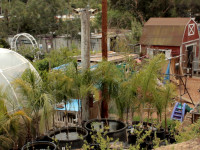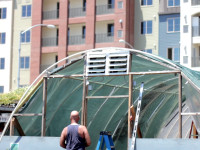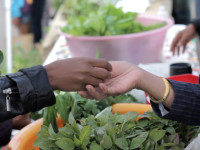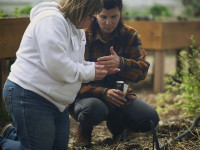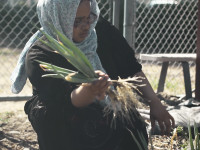City Farmers Nursery
City Heights
In 1972, a young Bill Tall started a small nursery on his parents land as an after school job. 40 plus years later the nursery and Bill Tall remain at the property. City Farmers Nursery continues to grow as the surrounding city expands and populates.
When urban agriculture ordinances changed and made farming in the city more accessible, Farmer Bill evolved the nursery: adding chickens and feed, opening his home to educational gardening and livestock workshops, and bringing in Allison Strand’s farm to table restaurant. Blurring the lines between business and community park.
Filmed in 2013, originally for Speak City Heights.
New Roots Aqua Farm
City Heights
A vacant lot in City Heights was reimagined as an urban farm using fish and hydroponics to stay above ground. A project of the International Rescue Committee – San Diego, the aquaponics farm acted as an additional training ground for farmers of the nearby New Roots Community Farm. Produce grown here was sold down the street at the City Heights’ Farmers’ Market.
At the garden, Malaki Obado shares his experience of growing up around agriculture and how understanding where your food comes from can promote a change in habits.
The project lasted a couple years before it started growing beyond the lot’s permitted use. Traditional gardening techniques are still in use, but the fish and hydroponics have been removed.
Filmed in 2011, originally for Speak City Heights.
City Heights’ Farmers’ Market
City Heights
When the farmers’ market opened in City Heights, a community with a population of nearly 80,000, it had very little competition in providing residents with farm fresh, local produce. The neighborhood had only one major supermarket, a few small ethnic markets, and corner stores with poor quality produce–if any. This market was up against public opinion that farmers’ markets were upscale grocery boutiques for wealthy consumers, and City Heights is a working class neighborhood.
Speaking with shoppers, farmers, and health advocates we see by bringing in farmers that grew rare cultural produce, the market was able to become a popular shopping destination for the Vietnamese residents in the area. Accepting WIC and food stamps encouraged low-income consumers to shop at the market. The Fresh Fund program helped expand residents’ budget for fresh vegetables and fruit.
The City Heights Farmers’ Market continues today, further more, it’s a community hub that promotes community health every Saturday morning.
Appearances: Laqeysha Sowunmi, Champion Mom, Blanca Melendrez, Director UCSD–Network for a Healthy California, Anchi Mei, IRC Food Security and Community Health Program Manager, Casey Anderson, SD County Farm Bureau Membership and Marketing Manager, Ayan Mohamed, Champion Mom using WIC, Alex Pheng, Oriental Farms–Fresno, Irma Timmons, Fresh Fund Recipient, Kap Nei Thing, Fresh Fund Recipient.
Filmed in 2011, originally for Speak City Heights.
Speak City Heights Journalist Megan Burks contributed to this video.
Crawford High School Garden
City Heights
The school garden at Crawford High School is an internship program in collaboration with the International Rescue Committee San Diego. Looking to foster the idea that organic farming is a possible career opportunity for urban youth who are often disconnected from the food system, the IRC New Roots Youth Garden Program trains students to develop job skills and introduces them to a food justice curriculum.
In the garden, we meet IRC mentor Kaley Hearnsberger teaching the farming trade, and students Perla Hernandez, Ntiriniga Etienne, and Valerie Christinat demonstrating the school’s salad bar compost program. Etienne, who grew up in a Tanzanian refugee camp, reminisces of when his mother would compost to grow fresh vegetables at the refugee camp.
Filmed in 2011, originally for Speak City Heights.
Talking Food Systems
San Diego residents are leading a movement to improve access to healthy food and economic opportunity through traditional community gardens and farmers markets; and innovative projects like backyard growers’ certification and urban farm stands. The movement has changed public policy making it easier for small-scale agriculture to thrive in the urban environment.
The reason behind this movement lies in the social inequities that exist within the conventional food system. These ideas are explored from the perspective of the communities adversely impacted by these social constructs. By addressing the various reasons why individuals find it difficult to sustain a healthy lifestyle, Land & Freedom shows how issues like food deserts, health, blight, crime and public transportation are interconnected.
Through participation in the project, residents become identifiable community leaders advocating for their neighborhoods. Their stories are an inspiration to others to get active in their community and develop an appreciation for natural foods and healthy lifestyles.
Margarita’s Fresh Flowers, Produce and Plants
Linda Vista
At Margarita’s Fresh Flowers, Produce & Plants we meet Santos Hernandez and his family. Santos, a Oaxacan native started a farmers’ market booth at Kobey’s Swap Meet on Sports Arena Blvd. before he opened his own roadside shop in 2000. Naming the market and nursery after his mother, Margarita, he sells bouquets of flowers cut fresh from Encinitas. The flower and vegetable transplants, along with the fresh produce in his shop come from his farm in Escondido. Now open seven days a week, plus two days at the swap meet with the help from his family, Santos leads a busy life. It’s a life he enjoys, spending time with his children and wife, getting plenty of exercise at work, being around healthy food all the time, and straying from harmful substances. The family business seems to be running okay for Santos, but he doesn’t see himself passing the business down to his kids. University and medical school is what he sees in his children’s future.
Linda Vista Farmers’ Market
Linda Vista
It’s another Thursday in Linda Vista. A group of women sit around a table at the Linda Vista Farmers’ Market chatting about their lives. We meet neighborhood resident Thuy Le, a Vietnamese refugee and senior on Social Security. She explains that when she was able to work she would buy organic produce, now on Supplemental Security Income (SSI) she’s not able to afford both rent and the produce at the farmers’ market. Thuy is concerned that the processed and pesticide-grown foods at the supermarket are bad for her health, but must buy them because of her limited income. Often she is not able to afford food at the farmers’ market or the supermarket and must seek emergency food distribution at Bayside Community Center or be indebted to her credit card company for end of the month meals. Regardless of purchasing produce at the farmers’ market, Thuy is there every week with friends seeking deals and enjoying the experience of the farmers’ market.
Linda Vista Community Garden at Bayside
Linda Vista
At the Linda Vista Community Garden at Bayside Community Center we meet resident gardeners Tomasa Ruiz and Yves Brancheau. Tomasa grows organic produce for her family and in the garden finds relief from the everyday stresses of raising teenagers. Yves teaches his young children about nature and reinforces healthy diets and exercise. The success of the garden highlights the obstacles around the neighborhood for expansion.
La Maestra Community Health Centers’ Garden of Hope
City Heights
At the La Maestra Community Health Centers’ community garden we find gardeners Norma Rodriguez and Norma Jerilla. Norma R. speaks of growing up in rural Mexico and how rural lifestyles by design are more healthier than living in the city. The garden reminds her of her younger years and helps maintain her health through exercise and fresh produce that’s hard to find at the short-lived nearby markets. Norma J. finds stress relief in the garden and access to produce grown without chemical pesticides.
Arroyo Paseo Charter High School Health & Sustainability Club
City Heights
Students at Arroyo Paseo Charter High School started the Health & Sustainability student club to work in the school garden. We’re introduced to students Khadija Osman, Ana Vega, and Cindy Perez. They speak of having tough times in other schools and found that the attention of the teachers they receive at Arroyo Paseo and project based learning like the garden club has attributed to their success in school. Khadija, a Somali refugee and Muslim, is torn between the traditions of her family and her goals of attending university, while being the target of prejudice. With the aid of her teachers in the new school, Khadija gets accepted to UC Merced and plans to attend in the Fall. The school’s approach to diverse students working together discourages the bigoted bullying that affects many schools.

